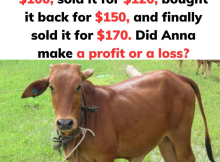Puzzles like this one can be deceptively tricky. If you’re reading this, you probably love a good challenge, or maybe you’re simply trying to figure out if Anna’s series of transactions left her with a profit, a loss, or broke even. Here’s the scenario: Anna buys a cow, sells it, buys it back, and then sells it again. But did she actually make money, or did she end up with a loss?
Let’s break down each step and see if we can figure it out together. Ready to tackle this puzzle? Let’s get started!

Common Mistakes When Solving This Puzzle
It’s easy to get tripped up by this puzzle, not because it’s complicated but because the sequence of transactions can be misleading. Here are a few common errors people make:
- Confusing Revenue with Profit: Many jump to conclusions based on total revenue, mistaking it for profit. It’s essential to keep in mind that profit is calculated after accounting for all expenses.
- Overlooking the Order of Transactions: Since Anna buys and sells twice, following the sequence is crucial. Skipping even one step can lead to an incorrect conclusion.
- Focusing on Totals Instead of Each Step: People often look at the final amount of money made and ignore the balance at each transaction stage, which is key to solving this puzzle accurately.
Now that we know where people often slip up, let’s go step-by-step through Anna’s transactions and determine if she made a profit or loss.
Step-By-Step Solution: Breaking Down Anna’s Transactions
Let’s analyze each transaction to track her balance and see if she came out ahead.
Step 1: Initial Purchase of the Cow
Anna starts by buying the cow for $100.
- Expense: -$100
- Current Balance: -$100
At this point, Anna’s balance shows a negative $100 since she spent money on purchasing the cow.
Step 2: First Sale of the Cow
Next, Anna sells the cow for $120.
- Revenue: +$120
- Balance Calculation: -$100 (initial expense) + $120 (revenue) = +$20
After this sale, Anna is up by $20. She’s already in profit, but the transactions aren’t over yet.
Step 3: Buying the Cow Back
Anna decides to buy the cow back, this time at a higher price of $150.
- Expense: -$150
- Balance Calculation: +$20 (balance after first sale) – $150 = -$130
Buying the cow back pushes Anna’s balance back into the negative, leaving her with a loss of $130. This is an important step, as it significantly affects her final balance.
Step 4: Final Sale of the Cow
Finally, Anna sells the cow once more, this time for $170.
- Revenue: +$170
- Balance Calculation: -$130 (balance after buying back) + $170 (final sale) = +$40
After this final transaction, Anna ends up with a positive balance of $40. This means that, in the end, she made a profit of $40 through all these transactions.
Conclusion: Anna Made a Profit of $40

The answer to the puzzle is that Anna did, in fact, make a profit, totaling $40. This example highlights how following each step carefully and tracking the balance after each transaction is essential for an accurate answer.
Why This Puzzle Stumps So Many People
This puzzle is an excellent example of how people often misinterpret financial transactions. Here’s why it’s tricky:
- Mistaking Revenue for Profit: The back-and-forth nature of the transactions confuses many, as they tend to focus on the amounts exchanged rather than the actual profit.
- Missing the Balance at Each Step: Without calculating the balance after every step, it’s easy to get lost in the sequence and misinterpret the final outcome.
- Forgetting That Order Matters: The transactions are not interchangeable. Each step affects the next, so skipping or altering the sequence would lead to a completely different result.
Final Thoughts: Share Your Solution and Challenge Your Friends
Did you get the right answer? If you found this puzzle engaging or challenging, share your solution in the comments! We’d love to hear your approach and see how you interpreted each step. Puzzles like this are great for exercising problem-solving skills and financial reasoning. If you enjoyed this one, try more puzzles to continue sharpening your logical thinking.
So, next time you’re faced with a similar puzzle, remember: sometimes, it’s all about the journey (or in this case, each transaction) rather than just the final destination. Keep puzzling and enjoy the thrill of solving challenges like these!

